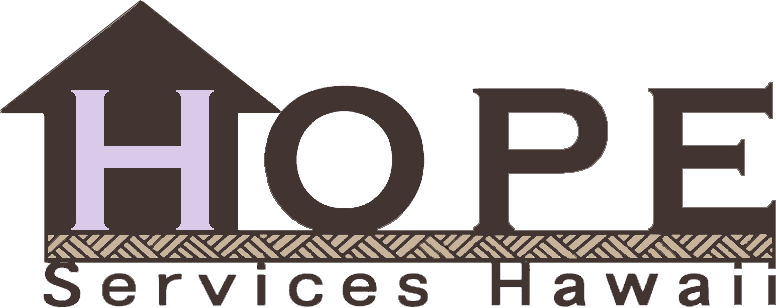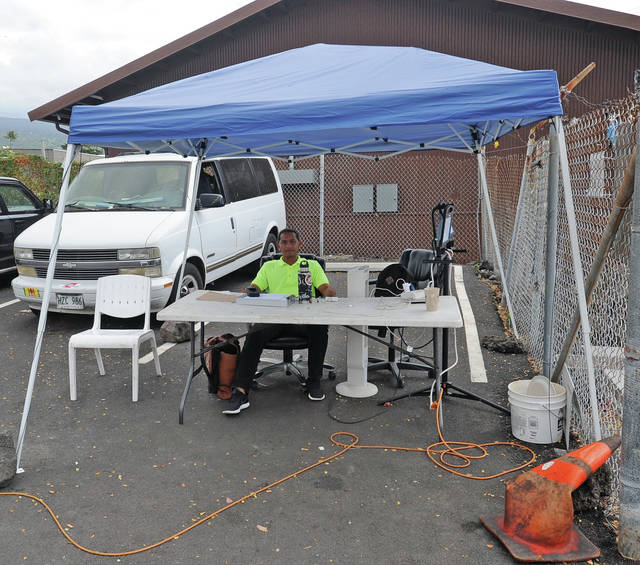KAILUA-KONA — A watchful eye can see a long way toward a safer community, but there are fewer of them now at the HOPE Services campus where many of Kona’s homeless come to congregate.
On Friday, HOPE’s one-month contract with Jan Guard Hawaii to provide 24-hour security services at the entrance to its setup off Pawai Place in the Old Industrial Area expired. The security company will now revert to posting personnel there from 10 p.m. to 7 a.m. daily.
HOPE leadership came to the county Department of Housing and Community Development in August to place the request after staff struggled to manage the behavior of an overflow of homeless loitering and lingering there.
“The campus was never intended to serve additional ‘campers’ on site,” HOPE CEO Brandee Menino wrote in an email to West Hawaii Today. “When the current administration closed ‘Camp Kikaha,’ the previous campers remained on site and we were left to manage the chaos that ensued with the additional campers congregating outside the micro-unit permanent supportive housing units and night time shelter.”
Camp Kikaha was born in the summer of 2017 when Mayor Harry Kim ordered police to clear Old Airport Park of the homeless camping there. Dozens of individuals were left to find new accommodations. As a temporary measure, the county created the camp next to Hale Kikaha, the micro-housing units built after Gov. David Ige’s first emergency proclamation on homelessness in the fall of 2015.
That site is located next to HOPE’s Friendly Place and the emergency shelter. The nonprofit also took on management of Hale Kikaha after its creation.
Menino said at maximum capacity, 50 households reside on the campus. When the county closed the camp in March, despite several of the homeless being placed in transitional housing elsewhere, many also stuck around.
Issues like trespassing, littering and indecent exposure also became greater concerns, said Mattson Davis, president of Ulu Development and former CEO of Kona Brewery.
“We really (were) not equipped to manage additional campers and the shelter and tenants (at the) Hale Kikaha Micro-Units,” Menino explained. “We did not have the staffing support to do that and operate the actual programs on campus. This led to frustration and exhaustion among my team often taking on more than we were equipped to handle.”
Rolling back
While Menino and her employees are optimistic the extended security contract served its purpose and brought some stability back to the site, the decision to revert to the 9-hour daily schedule can be summed up in a word — money.
The cost of a round-the-clock pair of eyes is more than $1,000 per day. A monthly tab of nearly $34,000 is one Kim said the Housing Department simply can’t sustain.
But as Menino’s comments indicate and as Davis said directly, just the presence of one uniformed guard in a chair made a significant impact on homeless behavior in the area.
Kona Brewery independently expanded its security contract with Kona Metro to extend to daytime visits, which added another element of crowd control.
A homeless man, who asked to be described only as Joseph for reasons of privacy and who sometimes frequents the HOPE campus but doesn’t live there, said he and others have noticed the increased security presence. He agreed that in the last weeks and months, general rowdiness and criminal activity seem to have declined.
According to numbers provided by Davis, Kona Metro documented 265 incidents between September-November, which included a handful of actual arrests. But roughly 35 percent of those incidents occurred in the first two weeks of the data sample. Since then, Davis said, there’s been a steady weekly decline.
He believes management of the flow of people in and out of the campus, keeping visitors to the prescribed amount at any one time and keeping away those banned from re-entering the property, is the crucial element the HOPE security expansion provided.
“Our people making controls, as well as Jan Guard working the door there, the people going in are being welcomed, the people going out are being accounted for, so it’s a part of the whole,” Davis said. “Basically, what I’m trying to show there is security is working. Don’t take it away.”
HOPE, however, doesn’t have a choice. The county provides HOPE’s funding through contracts and various nonprofit grants.
One mitigating measure, however, is possible. When the proposal for Hale Kikaha came down in 2015, lighting at the HOPE entrance to discourage camping overnight in vehicles or participating in nefarious behavior was part of the guarantee to business owners in the area.
Kim said Housing plans to soon make good on that promise.
“That is being done,” he said. “Once we get that plan, how many lights and where the lights are … they will implement that.” The governor on Friday issued a second emergency proclamation on homelessness to get various Ohana Zone projects off the ground. The new initiative, which came out of the Legislative session last year, put $30 million in 2019 funding behind the battle against homelessness.
Hawaii County is likely to get a piece of that money for Village 9, a widespread homeless housing project including supportive services like mental health and drug treatment to be located off Kealakehe Parkway. Master planning for that site and its Hilo counterpart will begin in January.
Once equipped, Village 9 may alleviate some of the issues around the HOPE campus simply by dwindling down the homeless population swirling in and around there.
Still, Kim said there are some realities about the homeless population in Kona and across Hawaii Island he and the rest of its residents must come to accept.
He cited a period of heavy rains, during which HOPE opened its shelter doors to anyone in need of cover. At that time, the transitional shelter had vacancies. They were offered to those who sought shelter from the storm, but some simply declined.
“There is a percentage, and the percentage depends on where we’re talking about, of people that don’t want housing programs,” Kim said. “They want that lifestyle.”
“We will do everything we can within our resources to help the homeless who want and need help,” Kim said. “But for others who choose this lifestyle, please be aware that these public and private lands are not your private dump, your private toilet or your private camping area.”
Read the news article direct through the Hawaii Tribune-Herald here.


